Living, Studying, and Volunteering in Montevideo, Uruguay
Study Abroad Semester Turned Year-long Exploration
Article and photos by Lindsay Stewart
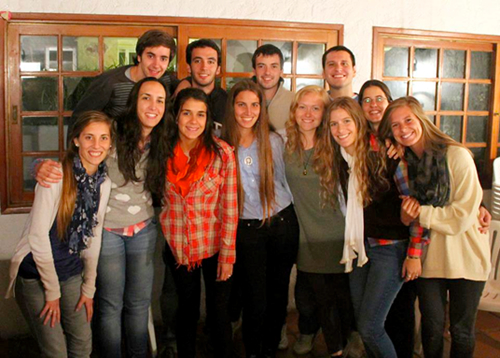
|
|
Lindsay with a group of Uruguayan friends.
|
As I sat in the living room of my host parent's house, having spent the previous three hours conversing nonstop with a Uruguayan friend to my right and an American friend to my left, I felt gratification. In this simple gathering, and others like it, I had accomplished what I most wanted out of my cultural immersion experience abroad: learning about the country through the eyes of people who live there.
I had persevered through the frustrations of improving in a foreign language. I had pushed myself to integrate into the local community…and the effort was paying off: I was flourishing.
Among other topics touched as we sat at the table enjoying “tomando la leche” (the traditional late afternoon pick-me-up of chocolate milk and sweet pastries), Gastón, Courtney, and I discussed the pervasive secularism in Uruguay’s society. A native of the country’s capital and by far largest city, Montevideo, Gastón was intrigued to hear our perspective and bounced off his reflections. He was interested and patient, as I expressed, in more or less fluent Spanish, my observations of how the lack of religion and spirituality in the public sphere affects Uruguayan society.
Yes, I felt gratified that the year brought such growth and companionship. I arrived in Montevideo, Uruguay, in July 2012, excited and nervous to begin my 6-month stay in this small country in the Southern Cone. Little did I know that I would stay an extra five months, living there until May 2013.
Know What You Want out of an Experience Abroad
Going on a semester of study abroad had been on my “to-do” list since high school. During my first two years on UNC’s campus (University of North Carolina at Chapel Hill), I never felt like I found my niche in academics or extracurricular activities. As these feelings persisted, I became even more motivated to study abroad: to learn differently, to experience something other than being on a college campus.
My first step in deciding on a program was to seriously reflect on my objectives for my semester abroad. The abundance and diversity of study abroad programs can be overwhelming; one is prepared to make the best decision when clearly understanding what one wants to get out of the experience. For example, first and foremost, I knew I wanted to improve my fluency in Spanish. Second, I knew that I did not want to go with a group of students from my university, as I might be tempted to spend most of my time in the comfort of the familiar. This way, I could narrow my options to several smaller programs in Latin America.
Ask yourself what your primary objectives are for studying abroad. Do not throw this to the wind! You may be attracted by being in a country different from your own for a few months, with the idea of having fun and traveling. However, based on my objectives and experience, I speak to those who want to be more than passing students and tourists. I write to those who aim to deeply experience, to immerse themselves, in the place where they study or participate in an internship abroad.
Uruguay: Somewhat Off-the-Beaten-Path, and Refreshingly Unique
Montevideo fits well with my objectives for a study abroad experience. The capital and important port city is becoming a popular destination for exchange students. The city is similar to Buenos Aires in having the feel of a European city; Montevideans are descended from Spanish and Italian families and retain many cultural and societal similarities. In contrast to its Argentinean counterpart, Montevideo is of a reasonable size, with greater security and a minimal number of tourists. The calm atmosphere is noticeable as one walks the streets and interacts with the people. Uruguayans are amiable and prefer to collaborate while seeking solidarity. Their saying, “nadie es más que nadie” (no one is better or more important than anyone else), is strongly reflected throughout their society.
Montevideo is a great place to improve one’s Spanish; the locals will gladly help you and, what is more, will be interested in why you have come to their country.
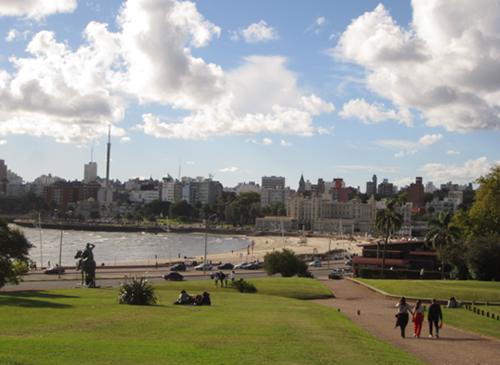
|
|
View of Montevideo’s promenade stretching for miles, separating the water from the city.
|
The city has a reliable and extensive bus system allowing quick transit in the center and its outskirts (each ride costs about 1 US dollar). Ask almost anyone on the street which bus to take to arrive at “such and such” street, and 8 out of 10 will be able to tell you several buses that will serve you.
Don’t let the palm trees and tropical vibe of search engine travel photos of Montevideo fool you...it gets cold in this southern city! Montevideo has four distinctive seasons, and the humidity makes the winter temperatures in the 30s and 40s degrees feel colder. Remember to pack a good coat whether you study in the spring or fall semester.
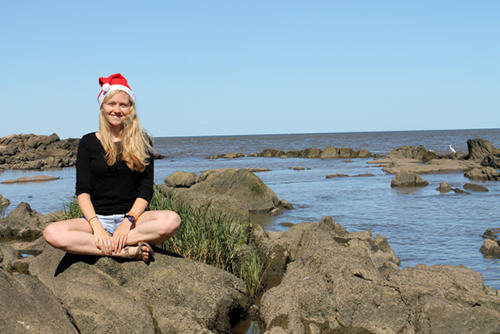
|
|
Christmas time feels like summer in Montevideo, which experiences weather with seasons inverted from much of Northern America.
|
Uruguayans tend to stick with the same foods with relatively slight variation: heavy on dairy products, pasta dishes, and lots of meat. As the exportation of beef is one of the country’s major economic assets, their meat is a source of national pride. If you are a vegetarian, be prepared to pay more for food, as supplementary foods (whole grain breads, tofu and soy products, and nuts) are imported and pricey. With a few exceptions, the clothing sold is expensive and low-quality. Pack personal hygiene products (especially shampoo, facial cleansers, and razors), which you will find exceptionally pricey in the country.
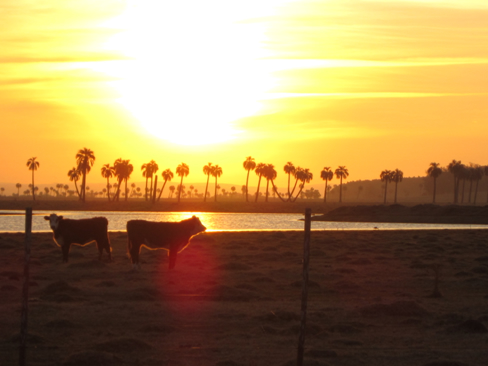
|
|
They say that there are five cows for every Uruguayan! Here are two cows standing in the interior of the country.
|
Logistics and a Word on Traveling in Uruguay
Uruguay, Argentina, and Chile do not charge entrance fees for North American visitors. Students can obtain a student visa or go on a tourist visa and leave the country every 90 days, which is a great excuse to travel.
Go to the central bus terminal where you can buy a reasonably priced ticket to almost any location in the country and to international destinations in Argentina, Chile, Brazil, etc.
Uruguay offers beautiful beaches along the eastern coast, including the world-renowned Punta del Este.
Academics in Uruguay
I studied in la Universidad Católica del Uruguay (la Católica), which has agreements with universities in over 30 countries, receiving some 70 international students each semester. The exchange program at la Católica offers classes specially designed for exchange students in Uruguayan History, Literature, and Culture and a Spanish language course. Even though the classes are conducted in Spanish, it is notable that the professors consider that Spanish is not the native tongue of most students. These classes are restricted to international students, creating the sense of being closed off from the university.
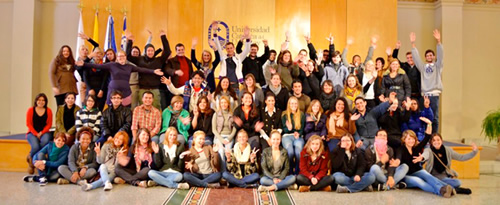
|
|
International Students in la Católica, July to December.
|
The other two major private universities in Montevideo, la Universidad de Montevideo (la UM) and la Universidad ORT (ORT), receive fewer international students and do not offer separate classes through their exchange programs (as does la Católica); take note that in la UM, the "Spanish language" course is not included in the semester’s tuition. Some schools have an agreement with the public university, la Universidad de la República Uruguay, which is free to all; however, being an international student there is more difficult as you are in a class with some 300 to 400 students.
Enroll in classes with local students to substantially improve your Spanish mastery for the fullest possible immersion. The class I enjoyed the most, and from which I progressed the most linguistically, was an intensive art history course in which I was the only foreigner alongside 15 Uruguayan classmates and a professor who spoke rapid-fire Spanish. This gave me an authentic taste of the Uruguayan university system and challenged my perceptions of classroom norms. For instance, I am not accustomed to the emphasis placed on collaborative effort among students, fostering an atmosphere in which students share notes, help classmates with comprehension, and study together.
Being Proactive During your Time Abroad
In seeking a non-touristy experience, it is helpful to integrate oneself into local organizations and activities — get involved with things that locals do! While the universities in Montevideo have some sports teams, they do not have the choice of extracurriculars and clubs as one might be used to on one's college campus; as a result, I looked elsewhere to get involved.
El Instituto Nacional de la Juventud (National Youth Institute) offers free cultural-artistic workshops — such as tango, salsa, and exploration of local music — for youth between the ages of 15 and 29. I participated in the tango workshop, which met twice a week. I had a great time meeting locals my age and learning about a genre of music and dance that is very special to the region.
The city government funds similar ongoing workshops in many other locations throughout Montevideo. If you are also looking to get involved in the community through service-oriented projects, this excellent resource will connect you with many organizations.
Don't Be Afraid to Change Your Plans
My, how a semester abroad flies by! Only towards the end of the semester did I begin feeling integrated in my surroundings: with my host family, the foreign language, friends, and activities. I started considering the possibility of staying an additional semester, considering that many international students stay for an entire year. After learning that I couldn’t remain in the university due to complications with receiving credits, I chose to take a gap semester from school.
The task was to construct what I wanted to do during the semester. Word-of-mouth networking helped me discover organizations where I could volunteer or participate in an internship. However, internships are still not integrated into the Uruguayan work culture, as they are in Europe and the United States.
I started my second semester as a volunteer with one of the National Youth Organization’s summer projects, in which we traveled along the beaches of Uruguay to promote physical activity among youth. I interned in the Office of International Relations at la Universidad de Montevideo during the school term. I worked as a volunteer in an educational center. I loved working as a volunteer with an organization called UNIDOS, Monday to Saturday, alongside two stable employees of the center; the experience gave me a more realistic view of the extreme poverty in Uruguay.
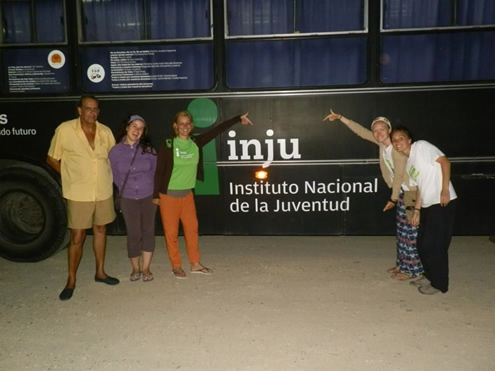
|
|
The INJU team and I during the summer project, La Rodada.
|
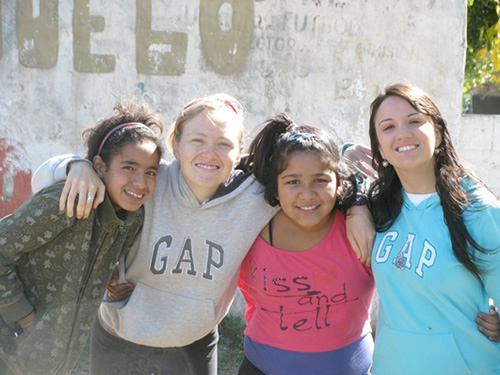
|
|
Volunteering with the UNIDOS organization.
|
Recommendation and Gratitude
I recommend taking a year to study (or intern) abroad. I found that during my first six months in Uruguay, I was getting used to my surroundings; during the second semester, I started to immerse myself fully in the experience of living in the country. I strengthened my relationships while deepening my involvement in meaningful activities with the community. In so doing, I learned to understand the Uruguayan way of life at a far more personal level than one semester allowed.
Lindsay Stewart attends the University of North Carolina at Chapel Hill, studying Spanish Linguistics and Music. Although she has traveled to several countries in Central America, this was her first time in the Southern Cone and her first extended experience in a foreign country.
|
